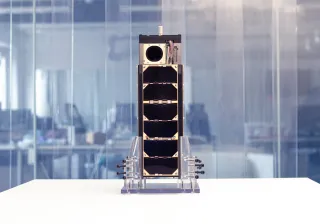NASA has welcomed me as a visiting researcher at its research center, to work there for a total of six months within one year. I just returned from my second visit, during which I focused on the pre-processing of NASA’s datasets. As a souvenir, I bring to VTT new expertise about eye movements and stronger networks.
VTT cooperates with NASA in the EYES project funded by the Academy of Finland. We investigate the possibilities of wearable measuring devices, new measuring technologies, and machine learning for assessing and predicting human cognitive state and fatigue.
In its laboratory, NASA has collected four impressive datasets involving situations with varying degrees of sleep restriction (e.g., one night of total sleep deprivation or several nights of insufficient sleep, i.e. cumulative sleep deprivation). During the study, NASA has measured eye movements several times and performed reaction time tests. I get to analyze these datasets and test VTT's methods with them. I aim to find out which eye movement parameter would be the most sensitive for each sleep intervention.
NASA appreciates a precise way of working
I spent my first research period at the NASA’s laboratory in May getting familiar with everything – access to NASA's facilities and systems obviously requires careful procedures that take time. During this period, I got to know people, attended lectures at Stanford University and prepared data for the next research period. In the second period, in June-September, I got down to hard work – I put together and combined materials from different sources, and changed them into the right format for analysis.
In this kind of work, pre-processing the material can take up to 80% of working time. My way of working is extremely precise and meticulous, which has drawn attention at NASA – I want to start analyzes from the scratch i.e., raw data, check the quality of the signals and understand how each data was collected. I have received praise for this: this is how data analysis should always be done and you can stand behind the results.
During the second research period, I completed preliminary results from one of NASA's datasets. The analysis will continue on my next visit in November, after which I will gradually move towards reporting. My goal is to turn my work into a scientific publication that examines the sensitivity and usability of the eye movement method, developed by NASA, in identifying different states of fatigue.
New knowledge about eye movements – networks are the biggest asset
Eye movement data has been collected using a method developed by NASA's Visuomotor Control laboratory. I work with the developers of this method, so I have been able to deepen my knowledge on eye movements research, especially regarding small involuntary eye movements.
At NASA, I have also seen the great value of networks for scientists. For example, the networks of Erin Flynn-Evans, the head of NASA's Fatigue Countermeasures Laboratory, are impressive – when discussing any topic, she can immediately name a few people to contact.
During the exchange, I have also become more aware of the importance of my own networks. I have had the opportunity to meet the world's top researchers who specialize in sleep and circadian rhythms. I will bring these networks with me to VTT. If we do research in this area in the future, I can help other people to participate in new research exchange.
My confidence has also grown in NASA. There is a huge difference between Finland and United States in how we talk about our work. Americans glorify the results of their work quite uninhibitedly, while Finns are more modest in presenting their results. For us Finns, a little extra boost to self-confidence is good – it's worth bringing up your opinions and results, and it’s more than okay to be proud of them.
NASA's research improves the quality of astronauts' sleep
My research exchange is now halfway through, and I have two visiting periods left in November and January. The research work in NASA's laboratories is very different from that at VTT – here we are right at the most applicable edge of research and develop technologies for the companies’ needs. NASA's laboratories, on the other hand, also conduct a lot of basic research.
NASA takes the results of basic research into space and to astronauts – the laboratory's research team does a lot of work to improve the quality of astronauts' sleep. It is important that research has a link to real life – this makes it concrete and particularly rewarding for the researcher.




